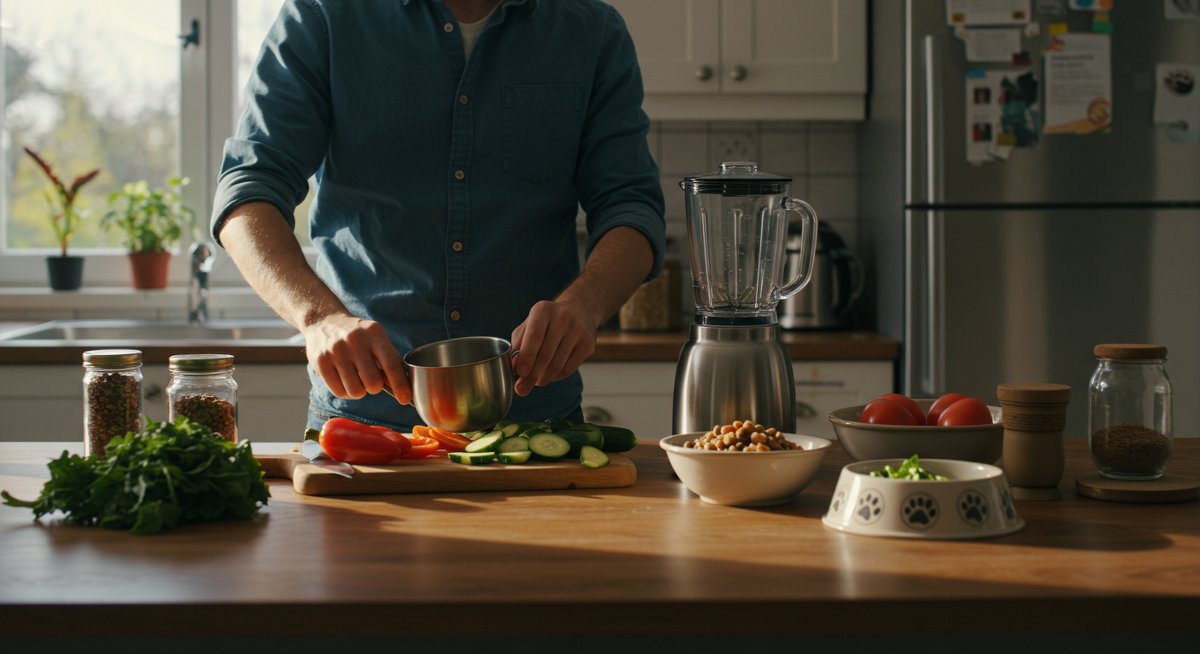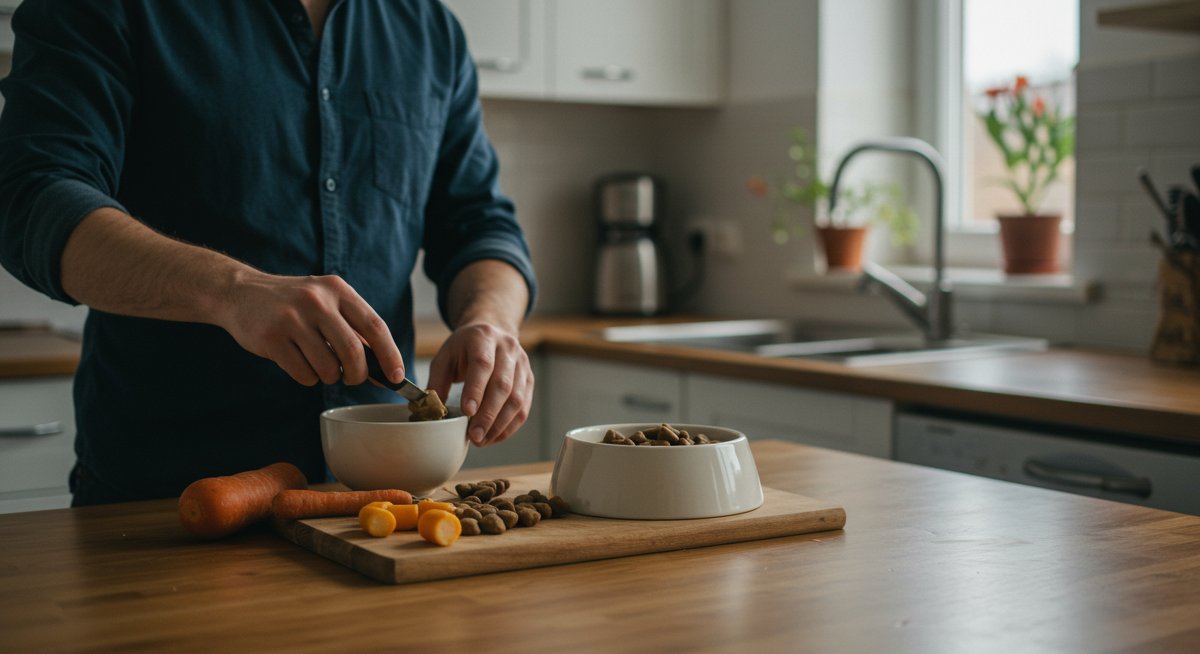Welcome to the world of dog nutrition! As a new pet owner, you're likely eager to provide the best possible care for your furry friend. One of the most impactful ways to ensure your dog's health and happiness is through a well-balanced and nutritious diet. This guide will provide you with essential information, practical tips, and delicious recipes to help you feed your dog. We’ll cover everything from the basics of dog nutrition to homemade recipes and how to choose the right commercial food. You'll gain the knowledge and confidence to create a diet that fuels your dog's energy, supports their overall well-being, and helps them thrive.

Why understanding dog nutrition is crucial for your new pet
Understanding dog nutrition is the cornerstone of responsible pet ownership. Just like humans, dogs require a balanced diet to maintain optimal health and well-being. The food your dog consumes directly impacts their energy levels, coat condition, immune system, and even their lifespan. A poor diet can lead to a variety of health issues, including obesity, skin problems, digestive upset, and even more serious conditions like heart disease. By educating yourself on the key nutritional components, you can make informed decisions about their diet and ensure they live a long, happy, and healthy life.
For example, a diet lacking in essential fatty acids can lead to dry, flaky skin and a dull coat. Conversely, an excessive intake of carbohydrates can contribute to weight gain and related health problems. A diet that meets your dog's specific needs will keep them feeling their best, giving you more quality time together. Furthermore, a healthy diet can often reduce veterinary bills by preventing diet-related health problems.
Consider the case of a playful Labrador Retriever puppy. Without the right balance of protein for muscle development, calcium for bone growth, and essential fatty acids for brain function, the puppy might struggle with energy levels, coordination, and overall growth. In contrast, a carefully planned diet will help your puppy grow into a healthy adult dog. Another example is an older dog with arthritis. A diet rich in Omega-3 fatty acids can help to reduce inflammation and improve joint health, allowing the dog to maintain an active lifestyle.
Essential first steps for dog care
Starting with the right information is key to ensuring your dog receives the best care. Begin by consulting with your veterinarian. They can assess your dog's individual needs based on their breed, age, activity level, and any existing health conditions. They can also help you determine the appropriate portion sizes and recommend specific food brands or recipes that are suitable for your dog.
Next, familiarize yourself with the basic nutritional needs of dogs. Dogs require a balance of protein, carbohydrates, fats, vitamins, and minerals. Protein is essential for building and repairing tissues, carbohydrates provide energy, fats support healthy skin and coat, and vitamins and minerals are crucial for various bodily functions. Read pet food labels carefully, understanding the ingredients listed and their nutritional values. Look for foods that list a named meat source (e.g., chicken, beef, lamb) as the primary ingredient and avoid foods with excessive fillers, artificial colors, or preservatives.
Consider your dog's specific life stage. Puppies, adult dogs, and senior dogs have different nutritional requirements. Puppies need more protein and calories to support their rapid growth, while senior dogs may need a diet lower in calories and higher in fiber to manage weight and digestive health. Finally, always ensure your dog has access to fresh, clean water. Hydration is essential for overall health and well-being.
Common challenges & how to overcome them
New pet owners often face challenges when it comes to feeding their dogs. One common issue is picky eating. Some dogs may turn their noses up at certain foods, making it difficult to ensure they receive the necessary nutrients. To overcome this, try gradually introducing new foods, mixing a small amount of the new food with their current food, and slowly increasing the proportion. You can also experiment with different textures, flavors, and feeding methods, such as using puzzle toys to make mealtimes more engaging.
Another common challenge is dealing with food allergies or sensitivities. If your dog experiences symptoms like itching, skin rashes, or digestive upset, they may have a food allergy. Consult with your veterinarian to identify potential allergens and consider a hypoallergenic diet. This may involve switching to a food with limited ingredients or a novel protein source, like duck or venison. It's important to note that food allergies can be triggered by common ingredients like chicken, beef, wheat, and soy.
Obesity is another significant concern for many dogs. Overfeeding, a lack of exercise, and the consumption of high-calorie treats can all contribute to weight gain. To address this, measure your dog's food portions carefully, limit treats, and ensure they get regular exercise. Your veterinarian can help you determine your dog's ideal weight and recommend a weight-management plan. In addition, certain dog breeds, such as Bulldogs and Dachshunds, are prone to obesity and require careful monitoring of their diet and exercise regimen.
Tips for success
Establishing a consistent feeding schedule and routine is crucial. Feed your dog at the same times each day and in the same place. This helps regulate their digestive system and promotes predictability. Most adult dogs do well with two meals a day, while puppies may require three or four smaller meals to meet their higher energy needs. Always follow the feeding guidelines on the dog food packaging, but remember that these are just recommendations; your vet can help you customize portion sizes.
When it comes to treats, use them sparingly, and choose healthy options like small pieces of cooked vegetables or fruits. Keep treats to a maximum of 10% of their daily caloric intake. Avoid giving your dog table scraps, as these can often be high in calories and unhealthy fats. Remember, training and feeding go hand-in-hand. Use positive reinforcement techniques during training, rewarding your dog with healthy treats for good behavior. This creates a positive association with food and strengthens your bond.
Consider your dog's activity level. A highly active dog will require more calories than a less active dog. Adjust their food portions accordingly to prevent weight gain or loss. Moreover, be patient and observant. Pay attention to your dog's body condition and adjust their diet as needed. Your dog's weight, energy levels, and coat condition are all good indicators of whether their diet is meeting their needs. Don't be afraid to consult with your veterinarian if you have any concerns or questions.
Building a strong bond with your dog
Feeding your dog can be an opportunity to strengthen your bond. Make mealtimes positive and enjoyable experiences. Hand-feeding your dog occasionally, or using food puzzle toys can make mealtimes more interactive and engaging, enriching your dog's environment. Praise your dog when they eat their meals, and create a calm and relaxed atmosphere. This will help them associate food with positive experiences, promoting a healthy relationship with you and their meals.
Participate in activities that involve food, such as training sessions. Use healthy treats to reward your dog for good behavior and positive responses to commands. This enhances communication and reinforces positive habits. Plan regular feeding times to provide structure and predictability to your dog's day, which can reduce anxiety and stress. This consistency in routine fosters a sense of security and trust, strengthening your bond. Furthermore, involve your dog in preparing their meals. This may involve measuring food, adding supplements, or preparing homemade recipes. This simple act can help them feel included and create an association between you and food.

Recommended products for new owners
For new dog owners, the right products can make all the difference. A good quality dog food is essential. Consider brands like Hill's Science Diet for balanced nutrition. These foods are formulated to meet the specific needs of different breeds and life stages. Also, consider a slow feeder bowl to prevent your dog from gulping their food too quickly, which can lead to digestive upset. A slow feeder can make mealtime last longer and create more engagement, helping with weight management.
Food storage containers are also crucial for maintaining the freshness of your dog's food. Ensure the container is airtight and kept in a cool, dry place. In addition, invest in a set of stainless steel food bowls. These are hygienic, easy to clean, and can prevent bacterial growth. Consider also adding a kitchen scale to measure food portions accurately. Using a scale is essential for ensuring you’re not overfeeding your dog, helping to prevent weight gain. Finally, consider a pet first aid kit, as well as vet-recommended supplements to support your dog’s health.
Quick troubleshooting guide
Here’s a quick troubleshooting guide for common dog diet-related issues. If your dog is a picky eater, try warming up the food slightly, adding a small amount of low-sodium broth, or mixing in a small amount of wet food. If your dog is experiencing digestive upset, such as diarrhoea or vomiting, contact your veterinarian immediately. They may recommend a bland diet or specific medications. Remember to introduce new foods gradually to avoid upsetting their digestive system.
If your dog is scratching excessively, check for food allergies. Eliminate potential allergens one at a time while consulting with your veterinarian. This may involve changing protein sources or adding supplements. If your dog is gaining weight, reduce their food portions and increase their exercise. Your veterinarian can help you determine the appropriate weight management plan. Finally, if you're concerned about any aspect of your dog's diet, don't hesitate to consult with your veterinarian. They can provide personalized guidance and address any specific concerns you may have.
Next steps in your pet parenthood journey
Congratulations on embarking on the journey of responsible dog ownership! Remember that feeding your dog a healthy diet is a continuous process that requires dedication and attention. Stay informed about the latest advances in dog nutrition by consulting with your veterinarian, reading reliable online resources, and engaging with fellow dog owners. Attend training classes or workshops that can provide valuable insights into your dog's behavior and nutritional needs. Always prioritise your dog's well-being, and remain flexible in your approach. Observe how your dog responds to changes in their diet and adjust your approach accordingly.
As your dog ages, their nutritional needs will change. Make sure to adjust their diet to meet their new needs, whether it's reducing their caloric intake or adding joint supplements. Keep a record of their diet, any changes you make, and any health issues they experience. This will help you track their progress and identify any potential problems. Most importantly, enjoy the experience of caring for your dog. The bond you share with your dog is a special gift, and by providing them with a healthy and delicious diet, you're showing them the love and care they deserve.